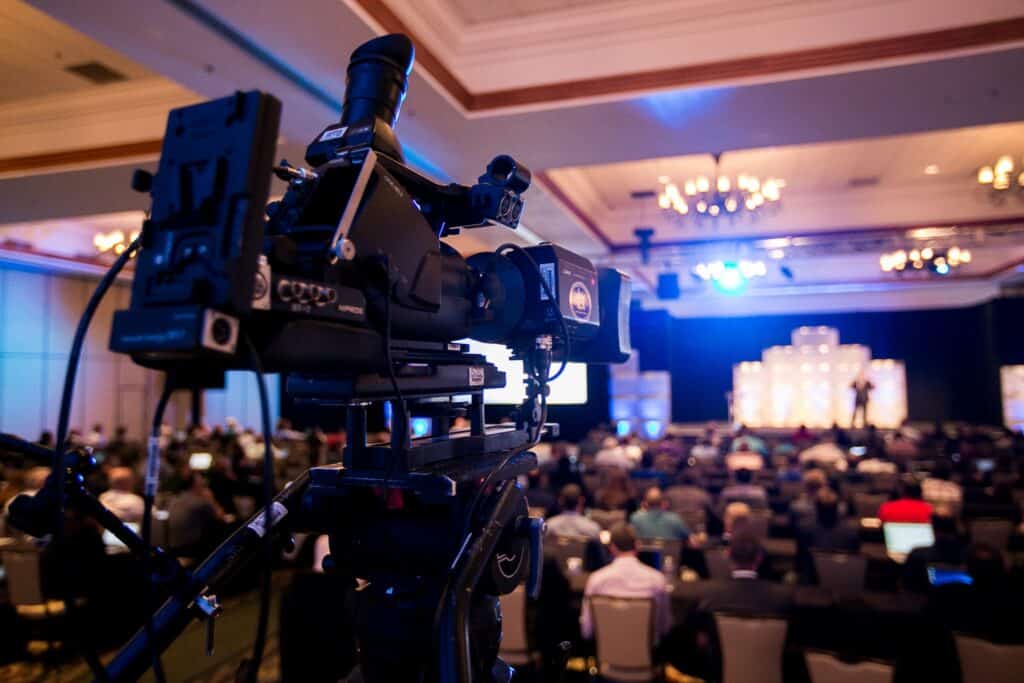What are the Benefits of Live Streaming Events
In the wake of the current global health environment, businesses and individuals have been severely impacted. With trade slowing, cities experiencing lockdown, and everybody on high alert, industries that rely on drawing massive crowds are struggling. Business conferences, concerts, lectures, and more are being cancelled or rescheduled to prevent the spread of coronavirus.
As someone within the events industry, you’re tasked to come up with an out-of-the-box solution to keep your event running. Thankfully, one technology in particular stands as a ring buoy in the turmoil tides of global health: Live Streaming.
For more on how live streaming can save your event, actionable steps you can take, and the overall benefits to live streaming in general, read ahead.
Keeping Your Event Live With Live Streaming
While live streaming may have been on your radar only peripherally before, now it should take centerstage. Live streaming allows attendees—speakers, businesses, and guests—to tune in virtually and experience all that the event has to offer.
To provide the right amount of engagement, you can’t just stick a camera in the corner; attendees need to feel like they’re in the actual space! That means offering:
- Freedom to virtually move around (change cameras, see different event spaces)
- Ability to interact (chat, submit questions to speakers, etc.)
- Watch and rewatch parts of the event (playback options)
With these goals in mind, you’ll need to prepare accordingly.
Setting Up Your Event Space and the Challenges of Live Streaming
To begin, there are two primary challenges that event planners need to be cognizant of:
- How can a remote presenter conference in from their home or office instead of being live at the event?
- If guests are unable to attend but have already paid for the conference, how can you allow them to remotely tune in and live stream the event?
Remote Presenter
With video platforms (like Zoom, Google Hangouts, etc.), a remote presenter can connect to your general session room. To have the bandwidth for proper audio and video, this would require a hardline connection of 10Mb upload and download speeds minimum.
Assuming your presenter has a webcam (on their laptop, for example), you can present their live video image on the bottom corner of the main presentation screen, with the majority of the screen showing the Powerpoint slide (which can be streamed through the in-house laptop). To do this:
- Set the primary show laptop to mirror a second laptop’s display and a duplicate of what’s going out to the main screens.
- Connect that second laptop to the Zoom/Hangouts meeting, so the presenter at home can see what the audience sees.
- For this to work, the presenter will need to say “Next Slide” to help control the flow of slides in the room.
This option would require both software and hardware, including:
- Zoom/Hangouts account, which is either Free, or up to $40/month.
- Two laptops, which event organizers like Vario can provide
- A Perfect Cue wireless presenter which has two USB outs to control two laptops at the same time
- Miscellaneous adapters/devices
- A moderator to manage the external connections.
- Network switch to allow two laptops to use one hardline connection
Remote Attendee
Depending on whether you want to go with a free live stream service or a paid option, you can use a video platform like Facebook Live, YouTube Live, Vimeo Enterprise, UStream, etc. The goal is to have the end user experience the conference as if they were there, which means a multi-camera feed is ideal.
Again, this would require a hardline connection (with 10Mb up/down minimum).
To have the best show possible, you will need to invest in:
- Multiple cameras that feed into a video switcher
- Broadcast video switcher
- Live stream show laptop
- Miscellaneous adapters/devices
- Video broadcast technician
The video switcher would allow the technician to toggle between camera angles and the Powerpoint slides to offer picture-in-picture and full screen views to the remote viewer. They will also be able to view the stream of questions that remote attendees send in and can coordinate with the speaker for Q/A segments. This accessibility is what gives the virtual attendee a great experience at home.
Be aware that the challenges you might experience will be specific to the platform selected. If you have never utilized these live streaming platforms before, it’s crucial you have someone experienced at the helm, handling all the potential problems—broadcasting issues, playback errors, connection issues, any of these can result in a poor viewing experience.
For this, there’s the Vario team. Not only will we help you plan and set up the event, we will ensure a smooth process all the way through the final clean up process.
Other Benefits of Live Streaming Events
Besides the benefits during a global health crisis, live streaming offers event planners new ways to engage and reach untapped audiences. Below, discover further benefits of live streaming and why this new event technology is gaining traction.
Engage Your Audience
There are countless benefits of live streaming, many of which target audience engagement. An engaged audience is likely to become a repeat customer. At its core, live streaming offers an effective way to engage attendees in the audience and those viewing from a screen.
Additionally, it provides viewers with:
- Authenticity – Being able to view an event live and unedited allows for a more humanized, genuine experience. Spotting stutters and stumbles can make content creators relatable and, thus, more appealing to watch.
- Community – Users can leave comments, enabling the development of connections with you and among each other. The audience can then develop a sense of community through the interplay, which improves the overall user experience. A positive user experience increases the likelihood that they will recommend you to their network. Resultantly, community-building creates an additional channel for promotion.
- Interaction – Not only can viewers ask questions and respond in real time, but presenters can also answer in kind. This dynamic with the online audience makes for a more engaging spectacle for the live audience as well. Facebook Live’s research supports the higher rate of interaction, revealing that users are 3x more likely to watch and 10x more likely to comment on a live video streaming than recorded footage.
- Transparency – Willingness to accept and answer real time feedback demonstrates a commitment to transparency. A live demo or tour can cement consumer trust in the company.
Create Urgency
As opposed to content that is available at viewers’ disposal, a live stream that is available for viewing one time only can push an online user to shift from passive to active engagement. Limited availability helps generate an online buzz and draws more spectators.
Broaden Your Reach
Contrary to what you may believe, live streaming events will not adversely affect in-person attendance. Statistics reveal quite the opposite effect.
A study conducted by Digitell discovered 30% of remote viewers convert to in-person attendants the event following year. James Parker, president of Digitell, sums the phenomenon up, “Think of online attendance, which is typically free, as a funnel that drives paid physical registration.”
Consider the following case studies that bolster Parker’s claim:
- In 2011, Coachella tickets sold out in three days. After live-streaming the 2011 performances, Coachella sold out its 2012 festival in just three hours.
- In the 1960s, the National Football League was concerned that televising games would destroy game attendance and diminish revenues. Yet, it ended up being one of the most lucrative decisions made in the sports industry. Nearly six decades later, 86 of the top 100 most-watched live streamed occasions from 2017 were sports events.
- PCMA live streamed select sessions of their physical event. The 2014 Convening Leaders conference benefited from this decision with a 40% increase in attendance, setting new records in Boston for physical registration and worldwide for virtual registration.
So, not only does live streaming grant businesses access to an audience that might not be able to make the trek to the physical occurrence, but it also persuades a sizable number of viewers to attend the next event in-person. Live streaming clearly has the potential to increase attendance as a whole.
Keep it Intimate
Live streaming doesn’t only apply to Coachella-sized affairs. It can also be an effective way of maximizing audience size but not exceeding venue capacity. Moreover, restricting attendees may help cultivate a more intimate experience for in-person attendants, which can encourage streamers to try to attend the next occasion in-person.
Find Targeted Niches
Live stream viewers take time out of their day to consume your content. Thus, this demographic already cares for and is engaged by your brand. So, you are already reaching a crowd more likely to become customers and continue to follow your company.
After the event, you can follow up with those that had the highest conversion potential—engaged audience members. These individuals can then be guided through your purchase funnel.
Don’t Break the Bank
Unlike earlier days, video technology and streaming services are no longer solely reserved for television networks. Although it may seem like top tier technology, live streaming is an attainable strategy for small and medium-sized businesses alike.
All that’s needed nowadays is a:
- Camera and minimal video hardware
- Stable internet connection
- Streaming platform
Saving via Streaming
You can actually avoid expenses by choosing to live stream. Rather than footing the bill for long-distance travel accommodations, streaming will save both parties time and money.
The following could be live streamed:
- Conference Events
- Course Seminars
- Meetings
- Training Sessions
Profiting via Streaming
On the other hand, live streaming can be used directly to generate revenue:
- Freemium – Instead of giving away content entirely for free, a freemium gives viewers restricted access. For unrestricted viewing, users must pay to watch the entirety of the event online.
- Pay-per-view – Everyone must pay to view the live stream of the event.
- Sponsors – While offering the live stream online, platforms or portals could pay you for the right to show your event. Or, companies could compensate you for displaying their advertisements. Ads are not likely to disturb viewers, particularly if the stream is free.
Cut Down on Production Time
Time is money. And, according to Hubspot’s research, it can take anywhere between four to eight hours to write a 1,500-2,000 word article. Putting together a basic vlog can eat up approximately two to three hours.
Save valuable hours spent splicing footage and throwing together an article with a live stream. After all, the content will produce itself, with nearly no extra time needed post-production.
Repurpose Material
Moreover, the value of the footage doesn’t disappear once the event is over. Hubspot disclosed that 52% of marketers, universally, confirmed that videos have the highest ROI. Unruly also revealed that recorded videos augment intent to purchase by 97% and brand association by a whopping 139%.
While it may require additional funds to offer a high-quality live stream, it will, undoubtedly, pay off. Once it’s over, you then have access to footage of the live video stream that can be shared and repurposed.
What could be done with the content?
- Create a highlight reel that’s easier to digest for new viewers.
- Grab stills for future posts or promotional content.
- Produce a teaser for subsequent events.
- Publish the transcript on your website.
- Upload it to Youtube.
Regardless of what is done with the footage, it has the potential to multiply the brand’s reach.
Get Feedback
As mentioned previously, live streaming opens the avenue of communication in a way that has never been possible before. With immediate responses from the audience, you have an extraordinary opportunity to consider clients’ opinions and adjust as necessary.
Surveys, polls, likes, and dislikes can let you know right away what content your target wants to see. The data will allow you to execute changes to improve future events and products.
Stand Out
Differentiate your business from others with live streaming. Not every organization has hopped onto the live streaming wagon yet, so incorporating it as a marketing tactic could give you an advantage—before the market becomes too saturated.
Here are some free live streaming services you could use:
- Facebook Live
- Instagram Live
- Music.ly
- Periscope
- Twitch.tv
- Youtube Live
Boost SEO
Take advantage of social media and post live stream content across multiple platforms to extend visibility, just as Coachella has successfully accomplished. By operating across several social media platforms, live streaming events:
Encourages intercommunication (e.g., likes, follows, shares)
- Builds social media presence
- Appeals to a broader audience
Video technology is an exponentially expanding industry, which means that it’s here to stay. The same is true of social media. By 2021, experts project that the live video streaming industry will be worth $70.5 billion. Fully understanding the usage and benefits of these tools has the power to transition prospects to clients.
Let’s Go Live
The coronavirus has impacted major events and may continue to do so for some time. Creative solutions are necessary if the show must go on. To that end, be sure to stay on top of the event tech trends this year. With a fast-paced market and changing consumer base, it becomes necessary to adapt constantly to remain in the spotlight.
It doesn’t, however, end at live streaming. That’s merely the beginning. You can incorporate technology to flip the script and keep all eyes on you at any organized affair. For example, find out just how facial recognition events are changing the event industry or read about Hologram Presentation: the New Conference Norm.
To truly emerge ahead of competitors, consider employing experts. An experienced team can make all the difference. While you focus on organizing the event of your dreams, Vario will handle the tech, and help you attain your objective at the venue. Take a look at Vario’s event portfolio. Leave it to the professionals.








